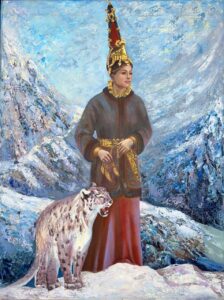ASTANA – The Kazakh capital hosted The Great Women of the World exhibition displaying paintings of Kazakh artists at the Has Sanat art gallery on Jan. 23.

Zhanuzak Mussapir’s painting “Kuishi Dina.”
According to Zhanna Yensebayeva, the owner of the gallery, the stories of women from the Silk Road region served as an inspiration. The historical figures from Kazakhstan, Azerbaijan and Türkiye, among other countries, are depicted in oil on canvas in the artworks.
“We need to tell our young generation about legendary figures such as Tomiris, Kuishi Dina, Aisha Bibi, Domalak Ana, and others,” said Yensebayeva.
Adilgali Bayandin’s portrait miniature depicting Dina Nurpeisova, a composer and musician, is also on display. Nurpeisova was only nine when Kurmangazy Sagyrbaiuly, the most renowned Kazakh folk composer and dombra player, first noticed her talent.
“In Dina’s musical pieces, one can sense the fragrance of the steppe, hear the rhythmic stomp of horse hoofs and the heartfelt melody of open grasslands. Through her compositions, she expressively narrates tales of independence and freedom. Listening to her music evokes an instant connection to the vastness of the Kazakh steppe, stirring deep emotions and a profound appreciation for our homeland,” she said.
Artist Aitkul Tasmagambetova shared her reflections on sources of inspiration.

Aitkul Tasmagambetova’s painting “Ak Kadyn – Princess of Altai”
“Our women are unique; while in some countries, women might be viewed as standing a step lower from men, our women stand shoulder to shoulder. They courageously fight alongside men while providing unwavering support to their families. Through my artistic endeavors, I aim to capture the essence of a resilient Turkic woman who embodies both strength and gentleness. Gentleness goes in tandem with inner strength, they never surrender their independence,” she said.
The portrait of Ak Kadyn, an Altai princess discovered during excavations in Siberia, is also one of the eye-catching pieces. In the unwavering gaze fixed upon the distance, the artist skillfully captured and conveyed the relentless determination of her character.
“She stands as our ancestress, and I have reconstructed her image based on photographs from the archaeological excavations. These are her attire details, from the dressing gown to embroidered saukele and jewelry,” said Tasmagambetova.
Yensebayeva noted that mummification was practiced at that time. Saukele, a traditional headdress, clothes, tattoos on her hands, and other belongings have been preserved. Six horses were buried next to her, indicating her status in society.

Adilgali Bayandin’s painting “Aisha Bibi”
“The tale of Aisha Bibi echoes the romance of Taj Mahal,” said Yensebayeva. “Aisha and Karahan, deeply in love, face separation when Karahan goes to defend his homeland against an enemy attack. Unfortunately, Karahan fails to return at the promised time, prompting Aisha to seek him out against her father’s will. Accompanied by 40 friends, she embarks on the journey but dies because of a snake bite. In mourning, Karahan performs an engagement ceremony, constructing a mausoleum as a symbol of eternal love for Aisha. The painter shows Aisha appearing to hold her breath, exhaling a bitter sigh that expresses the pain of separation from her beloved.”
The Great Women Of The World exhibition provides an empowering journey through the lives of remarkable women. Visitors to the gallery can witness the spirit of women who left an enduring legacy amidst their life’s hurdles. Their stories resonate with strength, resilience, and the unyielding pursuit of their dreams.
The exhibition will run through Feb. 19.

